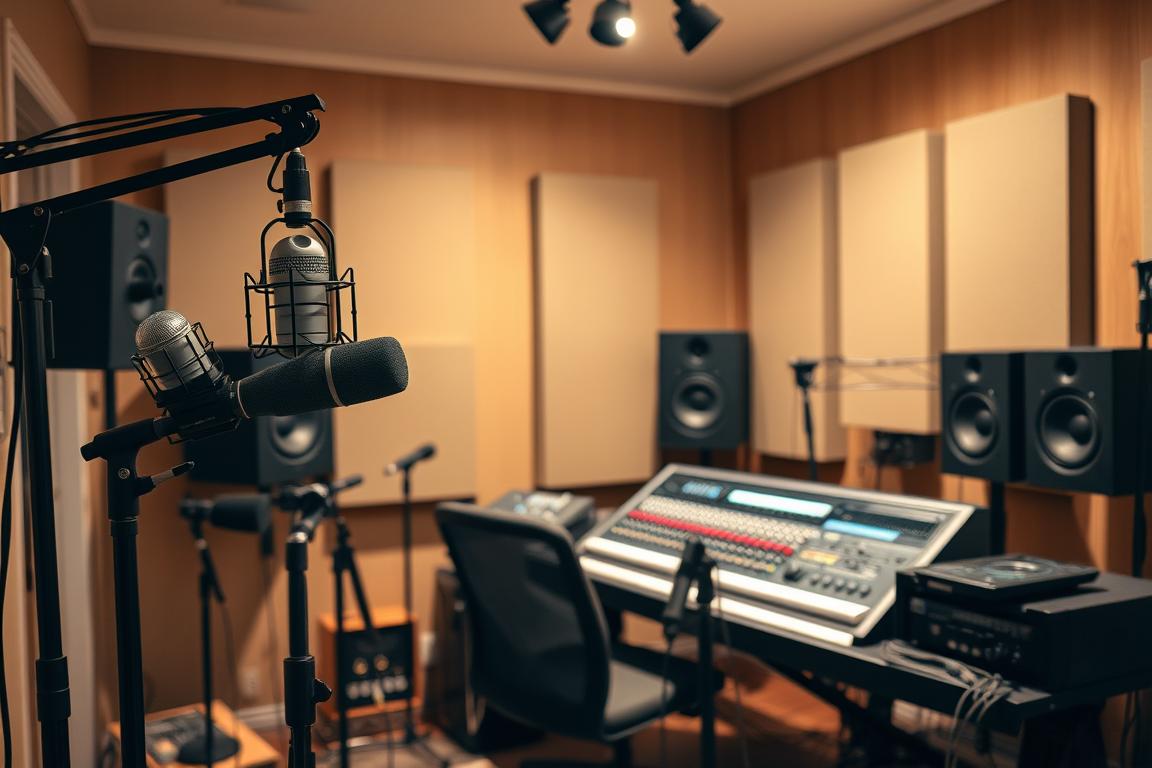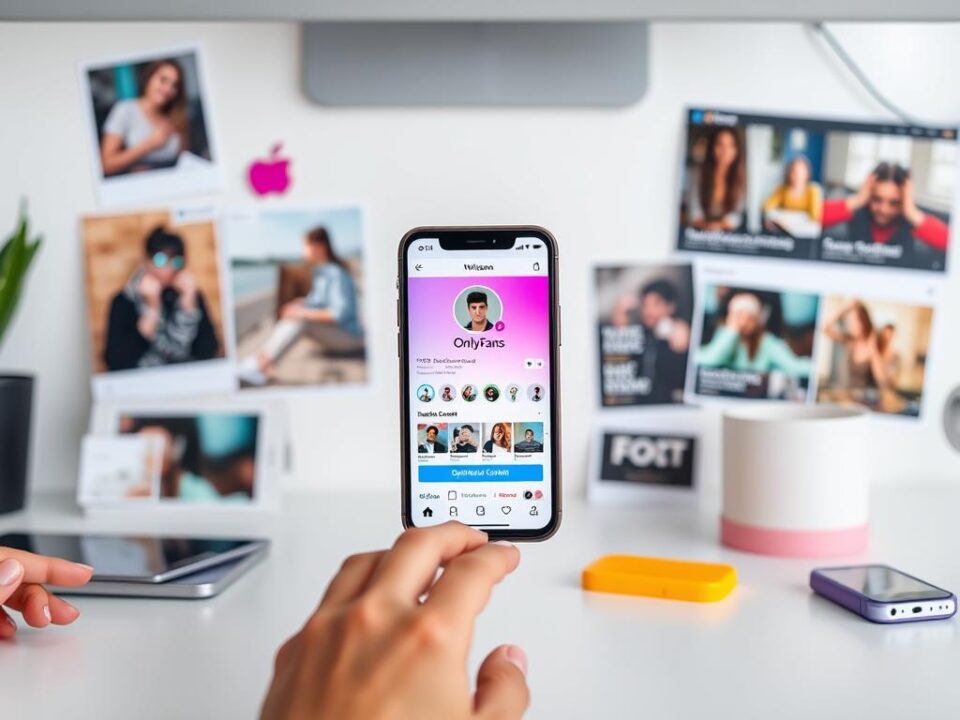Audio quality is just as key as visuals on OnlyFans. It can really make a difference in how your audience feels. Many creators now use external microphones to improve sound clarity.
This article will share tips and techniques to boost your video’s audio quality. We’ll cover how to make your videos sound as good as they look.
Creators often use dedicated cameras and Adobe Premiere Pro for better video quality. Tools like UniFab Audio Upmix AI are also popular for enhancing audio. Our guide will help you improve your audio setup.
By following our tips, you can make sure your videos are both visually stunning and aurally pleasing. Let’s start improving your content today!
Understanding the Importance of Audio Quality
Audio quality is key in video making, affecting viewer engagement. Good sound makes videos more engaging. It makes 70% of viewers more interested when the audio is clear.
How Audio Affects Viewer Engagement
Audio does more than just play sounds; it connects viewers to the content. Studies show audio is 40% of the viewing experience. Creators on OnlyFans who focus on audio see a 30% increase in subscribers.
Most OnlyFans users value audio quality, making it a crucial part of their subscription choice.
The Impact of Poor Audio on Content
Bad audio can hurt your content’s quality. Poor sound can make viewers lose interest and leave. Videos without good audio lose 50% of their viewers.
Today, with high consumer expectations, clear and immersive sound is essential for creators.
Choosing the Right Microphone
Finding the perfect microphone is key for great audio in your OnlyFans videos. There are many types of microphones, each with its own purpose. Knowing about these options helps you choose the right one for your needs.
Types of Microphones for Video Production
There are several microphone types great for video production. Each has special features for different recording needs. Here are some popular ones:
- Lavalier (Clip-on) Microphones: Small and discreet, these mics are perfect for interviews and presentations.
- Shotgun Microphones: Ideal for capturing focused sounds, they work well in noisy environments.
- Condenser Microphones: Sensitive and capable of capturing subtle audio details, they are excellent for voiceovers and music recordings.
- Dynamic Microphones: Durable and budget-friendly, they require no external power, making them perfect for beginners.
- XLR Microphones: Offering flexibility and control over sound, they often require an audio interface for setup.
How to Select a Microphone for Your Needs
When picking a microphone, think about your content and the audio quality you want. Consider these factors:
- Sound Quality: A good microphone can make a big difference in audio clarity.
- Pickup Patterns: Choose a microphone with the right pickup pattern such as cardioid, bidirectional, omnidirectional, or stereo, depending on your recording needs. For instance, the Yeti X offers four distinct pickup patterns, making it versatile for different scenarios.
- Noise Handling: Look for microphones that minimize background noise, enhancing overall recording quality.
Setting Up Your Recording Environment
Creating a great recording environment is key for top-notch audio in your OnlyFans videos. By cutting down background noise and setting up the right conditions, you can boost your audio quality.
Tips for Reducing Background Noise
To cut down background noise, try these tips:
- Use soundproofing materials like foam panels or heavy curtains to soak up unwanted sounds.
- Look for quiet spots, away from street noise and machinery.
- Keep windows and doors shut to block out external sounds.
- Use carpets or rugs to soften the room’s sound, reducing echo.
Ideal Room Conditions for Recording
For the best audio, focus on these conditions:
- Keep your recording area tidy; a clean space means clearer sound.
- Keep the temperature steady; extreme weather can mess with your gear and sound.
- Choose a room with few reflective surfaces to avoid echo and audio issues.
- Make sure there’s good air flow but avoid noise; proper ventilation is key.
Utilizing Audio Editing Software
To make great OnlyFans videos, using audio editing software is key. There are many tools out there, and beginners can find easy-to-use ones. Learning how to use these tools can really help improve your video’s sound.
Recommended Software for Beginners
For newbies, some tools are better than others:
- Audacity: A free and open-source digital audio editor that works on many systems.
- Garageband: A digital audio workstation for iOS and Mac, great for beginners.
- Adobe Audition: It’s advanced but easy to use, perfect for new editors.
- iZotope RX 10: Great for fixing audio, easy to learn but still professional.
- Avid Pro Tools: A top choice, complex but has lots of help for beginners.
Basic Editing Techniques to Enhance Audio
Using audio editing software well means knowing some basic tricks:
- Noise Reduction: It’s crucial for getting rid of background noise and making audio clear.
- Equalization (EQ): It helps make audio clearer and balances different sounds.
- Trimming and Fades: Cutting out unwanted parts and using fade effects can make transitions smoother.
- Volume Adjustments: Keeping sound levels consistent makes videos more fun to watch.
- Adding Transitions: Transitions between audio clips make listening smoother.
Leveraging External Sound Equipment
Improving audio quality is more than just picking the right mic and editing tools. Adding external sound gear is key to getting pro-level recordings. Using pop filters, shock mounts, and audio interfaces can really boost your sound and production quality.
Importance of Pop Filters and Shock Mounts
Pop filters cut down on noise from hard sounds like “p” and “b”. They smooth out your audio, making it sound better. Shock mounts keep your mic steady, reducing vibrations and noise from handling or the environment.
Together, these tools are vital for clean, professional audio. They help you capture sound without unwanted noise.
Integrating Audio Interfaces for Better Sound
Audio interfaces connect your mic to recording software, turning analog signals into digital files. Choosing a high-quality interface improves your sound quality. It makes your recordings clearer and deeper.
With other sound gear, audio interfaces make recording smooth. They help bring out the best in your content. Investing in them can really elevate your production.
Capturing Audio in Different Scenarios
Capturing audio in various environments requires understanding and adapting to the unique challenges each presents. Techniques for outdoor audio recording are different from those for studio setups. Knowing the best practices is key for creators to improve audio quality.
Best Practices for Outdoor Recordings
When recording outdoors, it’s important to monitor the elements. Here are some tips for achieving the best results:
- Wind noise: Use windshields on microphones to reduce unwanted noise from breezes.
- Avoid busy locations: Select quieter areas to minimize background disturbances.
- Check ambient sounds: Take a moment to listen and measure ambient noise before starting the recording.
- Adaptive equipment: Utilize directional microphones to focus on the main audio source, cutting out other sounds.
Techniques for Studio vs. Home Recordings
Studio techniques often involve controlled environments. When recording at home, implementing home recording best practices can yield high-quality audio. Key considerations include:
- Acoustic treatment: Use soundproofing materials to manage echoes and reverberation in the recording area.
- Microphone placement: Keep the microphone close to the speaker for cleaner sound capture.
- Use high-quality equipment: Invest in external microphones and audio interfaces for the best output.
- Monitor audio levels: Employ headphones during recordings to avoid echoes and maintain control over audio output.
Enhancing Audio During Filming
Getting great audio in your videos makes them more engaging. Using filming tips can make your audio better. Knowing how to place microphones and layer sounds is key for top-notch audio.
Placement Tips for Optimal Sound Recording
Where you put your microphones is very important for clear sound. Here are some tips:
- Put microphones near the sound source to cut down on background noise.
- Use directional microphones to catch specific sounds and block out others.
- Think about using more than one microphone for different angles.
- Listen to sound quality with headphones while you record.
Techniques for Layering Audio in Videos
Adding music and sound effects can make your video better. Here are some audio layering techniques:
- Use voiceovers to make important points clearer and add depth to the story.
- Choose background music that matches your video’s mood to grab viewers’ attention.
- Make sure dialogue is loud enough while keeping sound effects balanced.
- Focus on smooth transitions between clips to keep the audio flowing well.
Good audio quality is crucial for your video’s success. By learning how to place and layer audio, you can give viewers a better experience.
Post-Production Audio Enhancement
Improving audio quality in post-production is key to a great final product. Many techniques can make your projects sound better. These include making sound clearer, balancing levels, and mixing audio well.
Equalization and Compression Techniques
Equalization helps adjust sound frequencies to make everything clear. It ensures each audio part is heard well. By tweaking specific frequencies, you can get rid of muddiness and highlight important sounds.
Compression, on the other hand, keeps audio levels even. This makes your content easy to listen to from start to finish. Using compression right can prevent loud spikes and keep the audio balanced, making it sound more professional.
Adding Background Music and Sound Effects
Adding background music and sound effects can make your content more engaging. It’s important to pick sound effects that fit with the visuals but don’t drown out the main audio. Background music can also set the mood for your content.
Finding the right mix of dialogue, sound effects, and music is crucial. It can make your audio experience exciting and keep viewers interested.
Troubleshooting Common Audio Issues
Creating top-notch audio content means tackling various problems that pop up during recording and editing. It’s key to keep your audio clear and professional. Knowing how to handle issues like distortion and syncing problems can make a big difference.
Identifying and Fixing Distorted Audio
Distorted audio can really mess up your project. It usually happens when the recording levels get too high, making sounds sound unnatural. To fix this:
- Make sure your sampling rate is at 44.1KHz in your software, like Camtasia or FocusRite ASIO Control Panel. This is important for the best sound.
- Use top-notch microphones like the Shure SM7B or Electrovoice RE-20 for better voice quality. Avoid using built-in mics, as they often don’t sound as good.
- Keep an eye on your audio waveform for signs of low-frequency “humps,” usually around 200Hz. This might mean there’s unwanted background noise.
Solutions for Syncing Audio and Video
Getting your audio and video in sync is crucial for a good viewing experience. Using the right methods can make a big difference. Here’s how to sync them effectively:
- Use a hybrid recording setup with a preprocessor like the DBX 286S and a FocusRite 2i2 USB interface for the best sound quality.
- Record in a quiet place, like a homemade recording booth, to cut down on background noise that messes with audio clarity.
- Use audio editing software with tools for adjusting timing. Tools like Filmora can help clean up your audio and make it sound better.
Testing Your Audio Before Publishing
Before you publish, it’s key to test your audio. This step ensures your final product is top-notch. By doing a detailed audio test, you can spot any problems that might ruin the experience for your viewers. Remember, the preview stage is crucial for a great outcome.
Importance of Previewing Your Work
Using good headphones for audio preview is a must. They help you catch small issues that might not show up on regular speakers. Pay attention to how clear the sound is and if the volume is right. You want the voice to be clear and the background to add to the message, not take away from it.
Checklist for Final Audio Approval
Having a checklist for final approval makes your audio process smoother. Here are some things to include:
- Make sure there’s no unwanted noise in each track.
- Keep your mouth about six inches from the mic for clear sound.
- Check the volume levels to avoid distortion.
- Record each speaker on their own track for easier editing.
- Use tools like AI Audio Enhancer Magic Dust for extra polish.
Following these steps shows how important careful preparation is for audio quality. By sticking to your checklist, you’ll feel more confident in your audio’s quality as you finish your project.
Maintaining Audio Quality Across Platforms
For content creators, keeping audio quality the same on all platforms is key. Each platform has its own audio settings to ensure the best sound. Knowing these settings can make your videos more engaging.
To get the best sound, adjust your audio settings for each platform. This includes OnlyFans, YouTube, and social media. Each has its own audio needs.
Adapting Audio Settings for Different Uploads
When getting your audio ready for upload, adjust settings for each platform. Streaming services often suggest bit rates of 96 to 160 kbps. Some file formats, like MP3, can go up to 320 kbps for top-notch sound.
By meeting or beating these standards, you make your content more engaging. This can help keep viewers interested and improve how they see your content.
Understanding File Formats and Compression
It’s important to know about file formats and how to compress audio. Different formats can change how well your audio plays and works on different devices. For example, a higher bit rate means better sound but bigger files.
Finding the right balance between quality and file size is key. This helps your videos upload faster and makes them easier to watch. Using tools like audio denoisers and mixers can also make your sound clear and professional. This helps your content stand out online.







